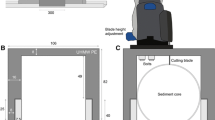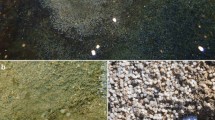Abstract
We describe a method for preserving the upper sediments of fragile sediment cores during transport from field sites and assess potential effects on subsequent laboratory analyses. This method addresses the need to minimize disturbance to the surfaces of unfrozen sediment cores used for paleoenvironmental or other high-resolution sedimentological analyses during transport. A polymer gel (sodium polyacrylate) applied above the sediment surface acts as a barrier to movement while also preserving surface undulations. The gel seal can preserve even exceptionally fine sedimentary structures (<0.2 mm) in the upper sediments of lacustrine and fiord sediment cores, but may react with organic material (e.g. algal mats) present on some sediment surfaces. This reaction creates an adhesive layer at the gel’s base but it can be handled effectively during sampling. The gel seal minimizes surface deformation and preserves surficial sediments better than traditional seals made of water-absorbent floral foam, wax or paper towel. In addition to permitting detailed sedimentary and subfossil investigations of the sediment–water interface, this method shows no detectable effects on measurements of total organic carbon or total nitrogen values in the sediment. This method is inexpensive, non-hazardous and applicable to many coring systems and sediment types.


Similar content being viewed by others
References
Blomqvist S (1985) Reliability of core sampling of soft bottom sediment—an in situ study. Sedimentology 32:605–612
Blomqvist S (1991) Quantitative sampling of soft-bottom sediments: problems and solutions. Mar Ecol Prog Ser 72:295–304
Fisher MM, Brenner M, Reddy KR (1992) A simple, inexpensive piston corer for collecting undisturbed sediment/water interface profiles. J Paleolimnol 7:157–161
Glew JR, Smol JP, Last WM (2001) Sediment core collection and extrusion. In: Last WM, Smol JP (eds) Tracking environmental change using lake sediments. volume 1: basin analysis, coring, and chronological techniques. Kluwer Academic Publishers, Dordrecht, pp 73–105
Lamoureux SF (1994) Embedding unfrozen lake sediment for thin section preparation. J Paleolimnol 10:141–146
Lamoureux SF (2001) Varve chronology techniques. In: Last WM, Smol JP (eds) Tracking environmental change using lake sediments. volume 1: basin analysis, coring, and chronological techniques. Kluwer Academic Publishers, Dordrecht, pp 247–260
Leonard E (1990) An assessment of sediment loss and distortion at the top of short gravity cores. Sediment Geol 66:57–63
Lukens Medical Corporation (1996) Zorbitrol® plus superabsorbent polymer powder (material safety data sheet). Lukens Medical Corporation, Albuquerque
Meyers PA, Teranes JL (2001) Sediment organic matter. In: Last WM, Smol JP (eds) Tracking environmental change using lake sediments. volume 1: basin analysis, coring, and chronological techniques. Kluwer Academic Publishers, Dordrecht, pp 239–269
Mueller DR, Vincent WF, Jeffries MO (2006) Environmental gradients, fragmented habitats, and microbiota of a northern ice shelf cryoecosystem, Ellesmere Island, Canada. Arct Antarct Alp Res 38:593–607
Van Hove P, Belzile C, Gibson JAE, Vincent WF (2006) Coupled landscape-lake evolution in the Canadian High Arctic. Can J Earth Sci 43:533–546
Acknowledgements
The authors gratefully acknowledge the support of the Natural Sciences and Engineering Research Council of Canada (NSERC) through research grants to S.F.L and W.F.V. and a postgraduate scholarship (PGS-D) to J.D.T. We also thank ArcticNet, the Royal Canadian Geographical Society, the Canadian Northern Studies Trust, the Northern Scientific Training Program and Queen’s University for their support of this research. Polar Continental Shelf Project and Parks Canada are thanked for their logistical support and excellent field assistance by Jérémie Pouliot, Denis Sarrazin and Julie Veillette (Université Laval), Eric Bottos (McGill University) and John Ennis (United Helicopters) is greatly appreciated. Linda Cameron (Queen’s University) provided information about Leco CNS-2000 analyser measurement error. Constructive comments by an anonymous reviewer improved this manuscript. This is PCSP/ÉPCP publication number 043-07.
Author information
Authors and Affiliations
Corresponding author
Rights and permissions
About this article
Cite this article
Tomkins, J.D., Antoniades, D., Lamoureux, S.F. et al. A simple and effective method for preserving the sediment–water interface of sediment cores during transport. J Paleolimnol 40, 577–582 (2008). https://doi.org/10.1007/s10933-007-9175-1
Received:
Accepted:
Published:
Issue Date:
DOI: https://doi.org/10.1007/s10933-007-9175-1




